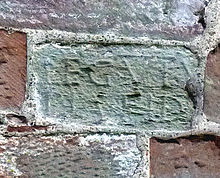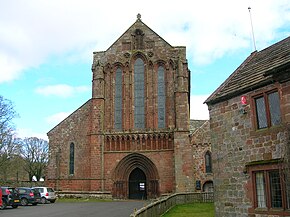
Cartmel Priory church serves as the parish church of Cartmel, Cumbria, England.

Gisborough Priory is a ruined Augustinian priory in Guisborough in the current borough of Redcar and Cleveland, North Yorkshire, England. It was founded in 1119 as the Priory of St Mary by the Norman feudal magnate Robert de Brus, also an ancestor of the Scottish king, Robert the Bruce. It became one of the richest monastic foundations in England with grants from the crown and bequests from de Brus, other nobles and gentry and local people of more modest means. Much of the Romanesque Norman priory was destroyed in a fire in 1289. It was rebuilt in the Gothic style on a grander scale over the following century. Its remains are regarded as among the finest surviving examples of early Gothic architecture in England.
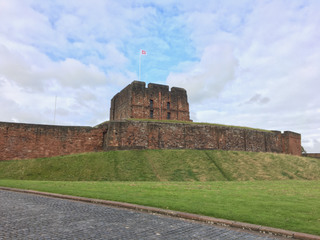
Carlisle Castle is a stone keep medieval fortress located in the city of Carlisle near the ruins of Hadrian's Wall. First built during the reign of William II in 1092 and rebuilt in stone under Henry I in 1122, the castle is over 930 years old and has been the scene of many episodes in British history.

Carlisle Cathedral is a Grade I listed Anglican cathedral in the city of Carlisle, Cumbria, England. It was founded as an Augustinian priory and became a cathedral in 1133. It is also the seat of the Bishop of Carlisle.
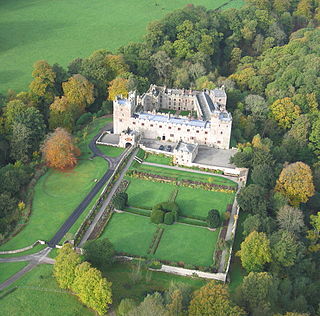
Naworth Castle, also known or recorded in historical documents as "Naward", is a castle in Cumbria, England, near the town of Brampton. It is adjacent to the A69 road from Newcastle upon Tyne to Carlisle, about 2 miles (3.2 km) east of Brampton. It is on the opposite side of the River Irthing to, and just within sight of, Lanercost Priory. It was the seat of the Barons Dacre and is now that of their cognatic descendants, the Earls of Carlisle. It is a Grade I listed building.

Birdoswald is a former farm in the civil parish of Waterhead in the English county of Cumberland. It stands on the site of the Roman fort of Banna.

Burgh by Sands is a village and civil parish in the Cumberland unitary authority area of Cumbria, England, situated near the Solway Firth. The parish includes the village of Burgh by Sands along with Longburgh, Dykesfield, Boustead Hill, Moorhouse and Thurstonfield. It is notable as the site of the first recorded North African (Mauri) military unit in Roman Britain, garrisoning the frontier fort of Aballava on Hadrian's Wall in the 3rd century AD. It is also where Edward I of England died in 1307.

The history of Cumbria as a county of England begins with the Local Government Act 1972. Its territory and constituent parts however have a long history under various other administrative and historic units of governance. Cumbria is an upland, coastal and rural area, with a history of invasions, migration and settlement, as well as battles and skirmishes between the English and the Scots.

Lanercost is a village in the northern part of Cumbria, England. The settlement is in the civil parish of Burtholme, in the City of Carlisle local government district. Lanercost is known for the presence of Lanercost Priory and its proximity to Hadrian's Wall.

St Bees Priory is the parish church of St Bees, Cumbria, in England. There is evidence for a pre-Norman religious site, and on this a Benedictine priory was founded by the first Norman Lord of Egremont William Meschin, and was dedicated by Archbishop Thurstan of York, sometime between 1120 and 1135.

Grinsdale is a village and former civil parish, now in the civil parish of Beaumont, in the Cumberland district, in the ceremonial county of Cumbria, England, historically in Cumberland. Grinsdale has a church called St Kentigern's Church. It is the source of the surname. It is also beside the River Eden. The civil parish was merged into Beaumont on 1 April 1934. In 1931 the civil parish had a population of 161.

St Martin's Church stands in the centre of the town of Bowness-on-Windermere, Cumbria, England. It is an active Anglican parish church in the deanery of Windermere, the archdeaconry of Westmorland and Furness, and the diocese of Carlisle. The church is recorded in the National Heritage List for England as a designated Grade I listed building. Its benefice is united with that of St Anne's Church, Ings; St Cuthbert's Church, Kentmere; St James' Church, Staveley; Jesus Church, Troutbeck and St Mary's Church, Windermere.

St Mary's Church is in the village of Abbeytown, Cumbria, England. It is an active Anglican parish church in the deanery of Solway, the archdeaconry of West Cumberland, and the diocese of Carlisle. Its benefice is united with those of six local churches to form the Solway Plain Team Ministry. The church is recorded in the National Heritage List for England as a designated Grade I listed building.

St Michael's Church is in the village of Burgh by Sands, Cumbria, England. It is an active Anglican parish church in the deanery of Carlisle, the archdeaconry of Carlisle, and the diocese of Carlisle. Its benefice is united with those of St Andrew, Aikton, St Mary, Kirkandrews-on-Eden with Beaumont, and St Peter, Kirkbampton. The church is recorded in the National Heritage List for England as a designated Grade I listed building. It is a fortified church standing on the line of Hadrian's Wall, and is unique in having had two fortified towers.

St Andrew's Church is in the village of Crosby Garrett, Cumbria, England. It is an active Anglican parish church in the deanery of Appleby, the archdeaconry of Carlisle, and the diocese of Carlisle. Its benefice is united with those of Kirkby Stephen Parish Church and St Mary, Mallerstang. The church is recorded in the National Heritage List for England as a designated Grade I listed building.

St Andrew's Church is in the village of Dacre, Cumbria, England. It is an active Anglican parish church in the deanery of Penrith, the archdeaconry of Penrith, and the diocese of Carlisle. The church is recorded in the National Heritage List for England as a designated Grade I listed building. The church stands near Dacre Castle.
St Mary Magdalene’s Church is a small mid-Victorian Anglican church on an isolated hillside in north-east Cumbria, England. Dedicated to Jesus' companion Mary Magdalene, it is the parish church of Gilsland, but is almost a mile from the village and may have been intended as much for the use of visitors to the nearby Gilsland Spa hotel as for the village. It is noteworthy in that the founder, G.G. Mounsey, a local landowner and first elected mayor of Carlisle, published a detailed summary of his reasons for building the church and thus threw into relief some of the reasoning behind Victorian church building and restoration.
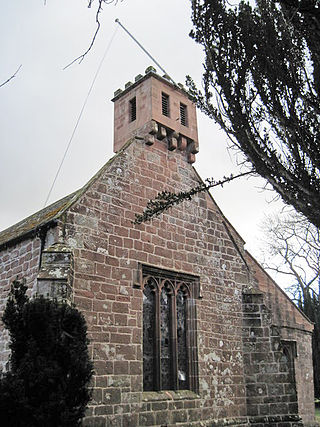
St Columba's Church is in the village of Warcop, Cumbria, England. It is an active Anglican parish church in the deanery of Appleby, the archdeaconry of Carlisle, and the diocese of Carlisle. Its benefice is united with St Theobald, Musgrave. and nine other parishes to form the Heart of Eden benefice. The church is recorded in the National Heritage List for England as a designated Grade I listed building. On Saint Peter's Day, 29 June, each year the church hosts a rushbearing ceremony.

The history of medieval Cumbria has several points of interest. The region's status as a borderland coping with 400 years of warfare is one. The attitude of the English central government, at once uninterested and deeply interested, is another. As a border region, of geopolitical importance, Cumbria changed hands between the Angles, Norse, Strathclyde Brythons, Picts, Normans, Scots and English; and the emergence of the modern county is also worthy of study.

